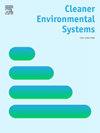Innovation ability of China's new energy industry from the perspective of new quality productivity
IF 4.9
Q2 ENGINEERING, ENVIRONMENTAL
引用次数: 0
Abstract
Objective
To quantitatively analyze the innovation capability of China's new energy industry from the perspective of new-quality productive forces, explore issues related to innovation efficiency, and provide references for enhancing industrial innovation capability and developing new-quality productive forces.
Methods
Based on the data of 23 new energy A-share listed enterprises in China from 2020 to 2023, this study constructs an innovation efficiency evaluation index system under the context of new productive forces. It applies the CCR-DEA and BCC-DEA models to analyze the static efficiency in 2023, and combines the Malmquist-DEA index to examine the dynamic efficiency from 2020 to 2023. Additionally, projection analysis is employed to identify issues of input redundancy and output deficiency, while the stochastic frontier approach is utilized to supplement the DEA analysis.
Results
The overall innovation efficiency of China's new energy enterprises was approximately effective but varied significantly. More than 60 % of enterprises needed to optimize resource allocation efficiency. About half of the enterprises faced decreasing returns to scale, with prominent issues of output shortages such as patent quantity and R&D expenditure. From 2020 to 2023, total factor productivity showed a trend of first increasing and then decreasing, with technological regression being the main cause of declining innovation efficiency.
Conclusion
It is necessary to construct a resource utilization system, policy guidance mechanism, collaborative ecosystem, and talent supply system adapted to new-quality productive forces, so as to optimize the allocation of innovation resources, break through technological bottlenecks, and promote the high-quality development of the new energy industry.
新质量生产力视角下的中国新能源产业创新能力
目的从新型优质生产力视角定量分析中国新能源产业创新能力,探讨创新效率相关问题,为提升产业创新能力、发展新型优质生产力提供参考。方法基于2020 - 2023年中国23家新能源a股上市企业数据,构建新生产力背景下的创新效率评价指标体系。应用CCR-DEA和BCC-DEA模型对2023年的静态效率进行分析,结合Malmquist-DEA指数对2020 - 2023年的动态效率进行分析。此外,采用投影分析来识别输入冗余和输出不足的问题,并利用随机前沿方法来补充DEA分析。结果中国新能源企业整体创新效率近似有效,但差异显著。60%以上的企业需要优化资源配置效率。约半数企业面临规模收益递减,专利数量和研发支出等产出短缺问题突出。2020 - 2023年,全要素生产率呈现先上升后下降的趋势,技术回归是创新效率下降的主要原因。结论构建与新型优质生产力相适应的资源利用体系、政策引导机制、协同生态系统和人才供给体系,优化创新资源配置,突破技术瓶颈,促进新能源产业高质量发展。
本文章由计算机程序翻译,如有差异,请以英文原文为准。
求助全文
约1分钟内获得全文
求助全文
来源期刊

Cleaner Environmental Systems
Environmental Science-Environmental Science (miscellaneous)
CiteScore
7.80
自引率
0.00%
发文量
32
审稿时长
52 days
 求助内容:
求助内容: 应助结果提醒方式:
应助结果提醒方式:


